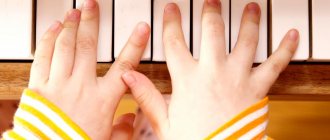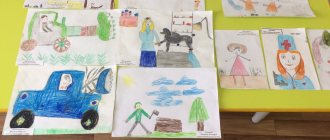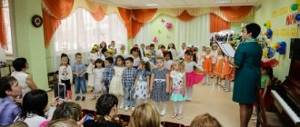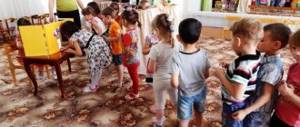Methodology for conducting physical education sessions in the preparatory group of preschool educational institutions
Restlessness, absent-mindedness, distraction by extraneous activities, talking with children during class - extremely rarely these are signs of disorganization or bad behavior. As a rule, this manifests itself as overwork and loss of interest in the activity being performed.
The duration of classes in the preparatory group reaches 30 minutes. The need for physical activity arises in children at the 14–15th minute of educational activity. The teacher should not wait for alarming symptoms. It is necessary to include a physical education break in the structure of each lesson.
In the middle of the lesson, which involves greater strain on the visual organs, gymnastics is performed for the eyes.
Methodological recommendations for conducting physical education sessions in the preparatory group:
- The task is formulated clearly for children (“Try to portray underground gnomes to music,” “Remember the tarantella movements that you studied in choreography, and use them in dance improvisation”).
- The content of physical education minutes is consistent with the topics of calendar planning classes. For example, the first week of September is dedicated in the preparatory group to the topic “We are future schoolchildren.” Research classes “What a first-grader needs”, active and role-playing games on school topics, reading poems and stories about young students are conducted. Physical education minutes are chosen not about animals, nature, transport, but about relationships in the children's team: “They are friends in our group”, “We stood up together”, “We thought together as friends”, etc.
- With pupils of the preparatory group, it is recommended to conduct physical education exercises that are familiar (from the middle and senior groups) with more complex tasks. Attributes are added, gymnastics are performed with a gradual acceleration of the tempo. You can add an element of competition: divide the group into two teams and see which one performs the movements from memory more accurately, and which one more expressively.
- The teacher may not complete physical education assignments. At the same time, he actively monitors the children’s actions: points out inaccuracies, praises them for good performance and emotionality in performing movements. From time to time, the teacher should still study with the children (as an option, during non-traditional physical education classes), because children strive to be like adults, they need motivation and an example before their eyes.
- Physical education is a moving element in the structure of the lesson. It can be carried out earlier than the conventional 15th minute if the teacher observes a loss of interest in the children’s activities. If the guys are passionate about something, let them finish it, and the physical education session will be in the second part of the lesson.
It is allowed (and in particularly intense classes it is recommended) to organize two dynamic breaks for children 6–7 years old.
With older preschoolers, the teacher does not perform physical education every time: if the pause is carried out in a non-traditional form or with new objects
Table: card index of topics for physical education minutes in the preparatory group
| General topic of classes (in accordance with planning in the preparatory group) | Physical education and exercise sets |
| "Soon to school" |
|
| "Autumn" |
|
| "My city, my country, my planet" |
|
| "New Year" |
|
| "Winter" |
|
| "Defender of the Fatherland Day" |
|
| "March 8" |
|
| "Spring" |
|
| “Goodbye, kindergarten!” |
|
The teacher’s methodological folder should contain a file of physical education minutes. The text of the dynamic pause and movement is written on the card. It is recommended to prepare dance physical education lessons on a separate sheet: indicate the names of the musical compositions, possible assignments and in which classes it is planned to take place. During consultations, parents are shown how to conduct physical education and are asked to familiarize themselves with the card index.
Photo gallery: examples of cards with physical education minutes
Dynamic physical education can be carried out in any lesson during the school year, because friendship is an off-season topic
During physical education, children improve plasticity and expressiveness of movements.
Physical education for the eyes “Winter Forest” is carried out during educational and artistic classes
Physical education is conducted in classes before Defender of the Fatherland Day, Victory Day and during holiday matinees
You can learn a poem for physical education with preparatory group students
Physical education can be carried out during speech therapy and speech classes
This dynamic warm-up will help the kids stay active during the next lesson.
Physical education sessions can combine breathing exercises and coordination of movements.
Physical education time plan
The duration of physical education in a lesson with children 6–7 years old is 1.5–3 minutes. The teacher predicts whether the structure will have one dynamic pause in the middle or one pause in the first and second half of the lesson. Accordingly, two short physical education minutes last 1.5 minutes each, one physical education minute per lesson lasts 3 minutes.
An approximate time plan for a short physical education session:
- Organizational moment, formation (scattered, in a circle, sitting on chairs) - no more than 15 seconds.
- Explanation of the content and task - 20–30 seconds.
- Performing motor exercises - 45 seconds - 1 minute.
An approximate time plan for a three-minute pause:
- Organizational moment, formation - 10–15 seconds.
- Explanation of the content and task - 20–30 seconds.
- Performing motor exercises - 1.5–2.5 minutes.
- Possible repetition - 30 seconds.
When performing exercises, preschoolers like to create images and depict familiar objects of reality
In the preparatory group, any physical education session contains a stage of explaining or reciting the task. Children do not improvise to music thoughtlessly - they like to create images or remember movements voiced by the teacher. Electronic physical education minutes usually begin directly with a demonstration of exercises, so the teacher precedes the viewing with the instruction: “Let’s do gymnastics together with the Kukutiki. Be careful, tomorrow we will repeat the movements without video recording!”
Table: synopsis of physical education in the preparatory group (fragment)
| Author | Shmakova N., educational psychologist, teacher, MBDOU D/s No. 85 “Gvozdika”, Ulyanovsk. |
| Progress of the physical education session | Our gander gets up at dawn, (From the position of the main stance, raise your arms up and stretch) He runs down the hill towards the river. (Bend your arms at the elbows, run in place) He likes to do goose exercises in order. (March in place) To begin with, run in place, (Run in place) Wings apart, but paws together. (Spread your arms to the sides, jump, land, legs together) Exercises for the neck to grow even longer. (Head rotation) Tail training, (Hips rotation) And then - plummet from the bridge. (Sit down and jump forward) He swims to the middle, (Imitation of breaststroke or crawl swimming styles) Cleans his paws, washes his back. (Stroke the right and left arms, then the back) The drake shouted: “Quack-quack! (Arms to the sides, bend at the elbows, fingers into a fist) Our athlete is a gander!” (Slowly spin around, stepping from foot to foot) V.: Tired, ganders! It's time to have lunch. And here comes the dragonfly. Performing visual gymnastics. <…> |
| Reflection stage | Q: Why do we do physical education and visual gymnastics? Who did it best? (Children's answers). |
| Quote from: https://www.maam.ru/detskijsad/konspekt-fizkultminutki-v-podgotovitelnoi-grupe-dlja-detei-s-narushenijami-zrenija-na-temu-gusak-fizkulturnik.html | |
Physical education minutes are a time-tested health-saving technology for working with preschoolers. They are performed by children in the nursery group by stamping, clapping and rattling a rattle. Students in the middle group improve motor skills, attentiveness and dexterity during dynamic pauses. But physical education sessions are extremely important for future schoolchildren: they are a way to develop beautiful posture, take care of maintaining physical health and a positive mood.








